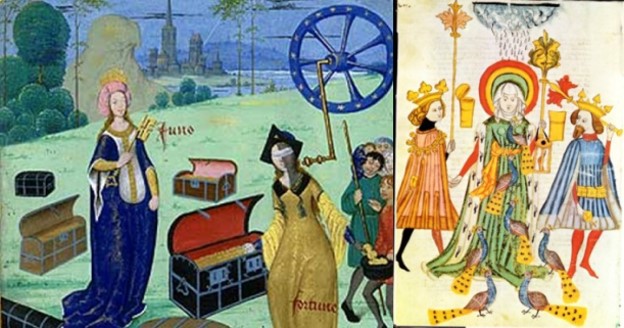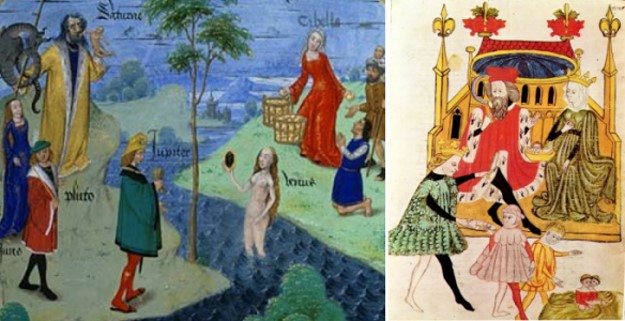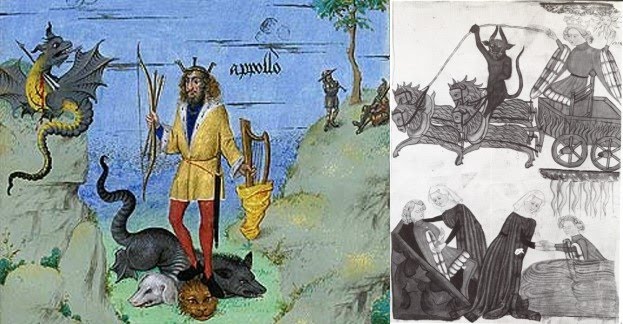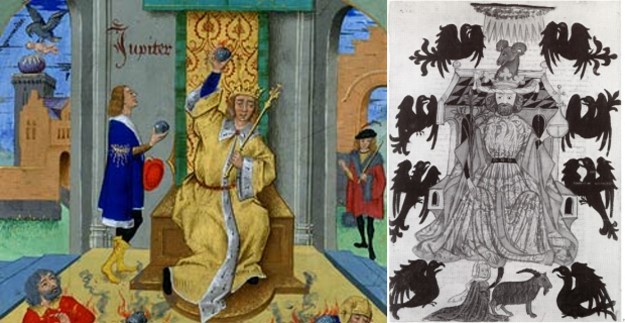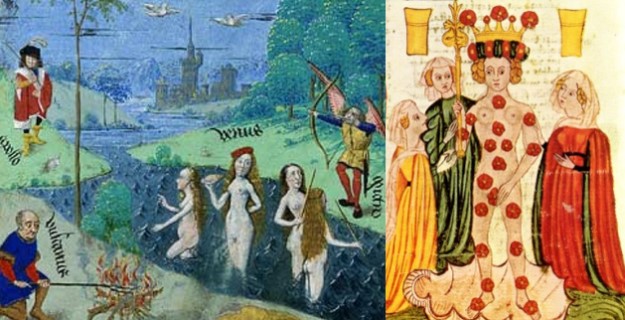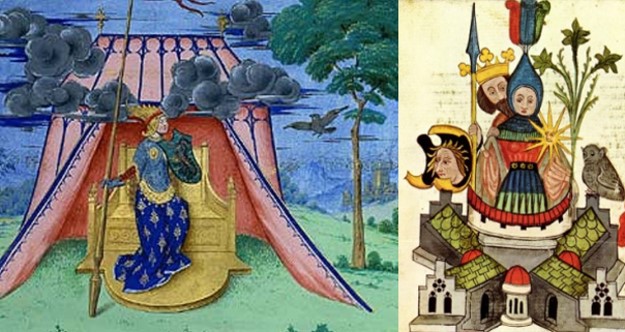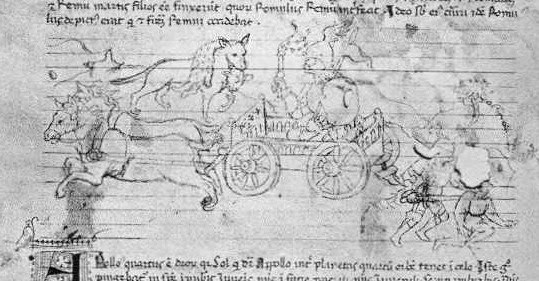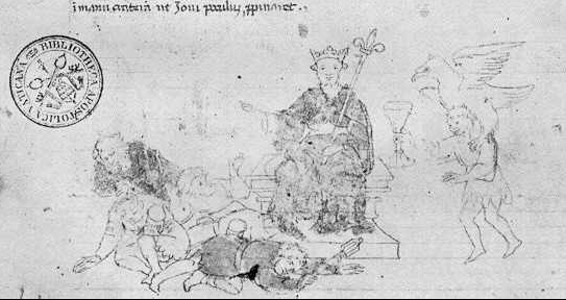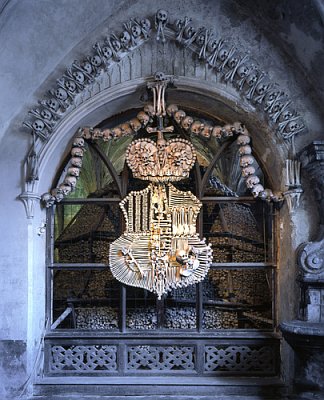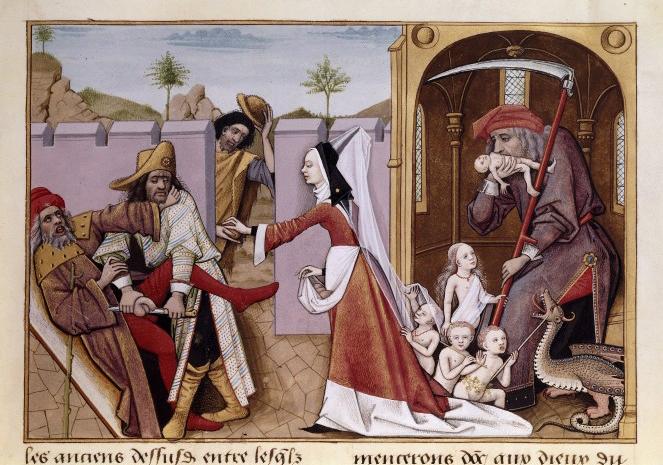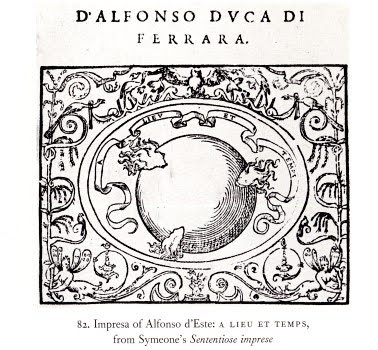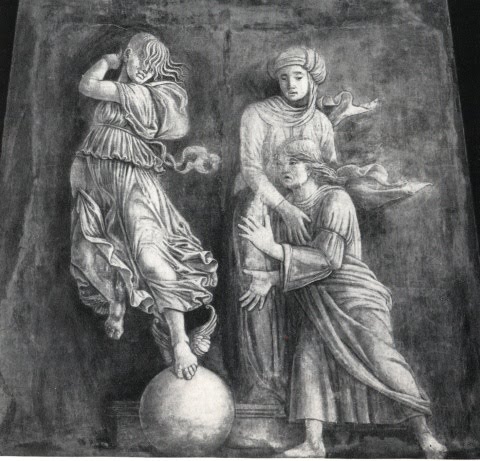mikeh wrote:I see what you mean about "copying the names." But in the article you linked to, I cannot tell who the alchemists are, as opposed to other persons, without doing a lot of translation work first. And there are many, many alchemists. For the moment, I will stick with English-language sources for the names and use sources in other languages for details on the ones that look promising. Thanks for the suggestion of making names a focus.
Alright, I decided to help you a little bit ...
Albrecht III of Bavaria-Munich
http://de.wikipedia.org/wiki/Albrecht_III._%28Bayern%29
http://de.wikisource.org/wiki/ADB:Albre ... BCnchen%29
John the alchemist ... already told about
Kuno of Falkenstein, archbishop of Trier, two archbishop generations after Balduin
http://de.wikisource.org/wiki/ADB:Konra ... alkenstein
http://de.wikipedia.org/wiki/Kuno_II._von_Falkenstein
Werner of Falkenstein, his nephew
http://de.wikipedia.org/wiki/Werner_von_Falkenstein
Johann II of Baden
this was also a archbishop of Trier, likely he had heard from alchemical wonder stories
http://de.wikipedia.org/wiki/Jakob_II._von_Baden
was cheated by an "alchemist"
http://books.google.com/books?id=FtoAAA ... ie&f=false
The biographies don't speak of alchemy, but this occupation not naturally lies at the surface.
****************
Passau-or-Leuchtenberg-or- Grafschaft Hals circle (South-East Germany) "Alchymey teuczsch, codex. pal. Germ 597):
Niklas Jankowitch (had master function)
Michael Prapach
Michael Wülfling
a Friedrich (?)
That's just "Alchymey teuczsch" (means German Alchemy), there is a group of authors around the Leuchtenberg-family. This region is east of Ratisbon (Regensburg), not too far from Prague, not too far from Nurremberg.
Johannes von Leuchtenberg
Gerhard von Leuchtenberg
Graf "zu Hals"
Salman Teublein (a Jew)
see:
http://books.google.com/books?id=6_JS90 ... in&f=false
That's a story of two cousins, who hired a Jew, that was an alchemist.
Paulus Eck von Sulzbach
http://de.wikisource.org/wiki/ADB:Eck_v ... bach,_Paul
writer of alchemical works
Landgraf "Wilhem von Hessen" (c. 1500)
seems to have sponsored the above eck von Sulzbach)
Bärbel von Ottenheim
(this "Bärbel" ironical had to do with a "Lichtenberg"-family, which easily might be taken to have something to do with the Leuchtenbergs, but this seems not to have been so; this is an Alsace-story)
she got the accusation to have been a witch
Hinrich von Plauen
(had to do with the Schwarzenburg, wich earlier belonged to the Leuchtenbergs)
... Schwarzenburg ... here I started to think ...
The Leuchtenbergs had a great time in 14th century, when Charles IV. had been emperor. The "Schwarzenburg" they got in ...
Nach der Landesteilung von 1331 kam die Herrschaft zum Herzogtum Heinrichs XV. des Natternbergers, dieser verkaufte die Burg aber im folgenden Jahr für 3000 Pfund Regensburger Pfennige zusammen mit Rötz und Waldmünchen an den Landgrafen Ulrich von Leuchtenberg. Er musste sich dabei verpflichten, 400 Pfund Regensburger Pfennige in die Burg zu verbauen.
... c. 1332. then the Leuchtenberger had them till ..
Die Leuchtenberger besaßen die Herrschaft Schwarzenburg-Rötz-Waldmünchen bis auf eine Verpfändung zwischen 1364 und 1367 an Georg Auer von Stockenfels bis etwa 1404, als sie die Herrschaft an Amalia Kagerin von Störnstein und ihre Söhne Hinczik und Hans die Pfluge zu Rabenstein verkauften. Unter den Pfluge, zuerst unter Hinczik, der nach 1460 verstarb, dann unter seinen Sohn Sebastian, er starb 1491/92, beide waren lange Zeit Pfleger zu Cham, und seinem Enkel Hinczik d.J., der 1495 gestorben ist, konnten sie die Rechte und Bedeutung der Herrschaft noch steigern. Zwischen 1439 und 1460 sind nicht näher bezeichnete Baumaßnahmen für 600 Gulden bekannt, sicher wurden zu dieser Zeit die drei noch erhaltenen Halbrundtürme, einer an dem turmförmigen Wohnbau der Hauptburg, einer innerhalb der Westbastion und einer neben dem erhaltenen inneren Tor der Vorburg, erbaut. Eventuell stand auch auf der gegenüberliegenden Seite des Tores noch ein zweiter Turm. Der Grund für die Verstärkung der Befestigungen dürfte wohl in der Bedrohung der Region durch die Hussitenkriege liegen. Die Schwarzenburg war 1433 Sammelplatz des unter Hinczik Pflug stehenden Heeres, das in der siegreichen Schlacht bei Hiltersried zu Bekanntheit gelangte.
1495 verkauften die Erben Hinczik d.J. für 36.000 Gulden die Herrschaft an Heinrich von Plauen, dem Burggrafen von Meißen. Heinrich war bis 1505 in Besitz von Burg und Herrschaft, er ließ umfangreiche Baumaßnahmen für 4.000 Gulden durchführen. Damals entstanden wohl die drei Bastionen, das Rondell, das Vortor der Vorburg und der ausgemauerte Halsgraben.
.. in 1404. Later in 1495 Heinrich Plauen had it till 1505 ... Heinrich von Plauen was also called an alchemist. What did he want with the Schwarzenburg, far away from his normal region Meissen? This puzzled me ... looking later for Heinrich von Plauen, I got that there were many Heinrichs von Plauens, that one, who was interested in alchemy, was the Deutschordenmeister, with strong involvement in the catastrophic battle of Tannenberg 1410, which prepared the downfall of the Deutscher Rittterorden. The Heinrich of Plauen, which, who bought the castle Schwarzenberg, was a later follower, who - curiously - got a rather successful son, who attacked the Plassenburg in Kulmbach in 1553 and died at that opportunity. Plassenburg was earlier the selected place for John the alchemist ... somehow strange.
But the idea, which initiated my interest, was ... "Schwarzenburg? Alchemy? Gun Powder?" and so I started to look for Bertold Schwarz, a famous, but somehow very legendary inventor of the black powder, which changed the world. Very much contradicting stories about him. Many have searched for him, nobody really have found him. Well, indeed an invention, which could cause some interest in alchemic experiments ... his heirs would follow these paths. The Leuchtenbergs showed a clear bundled interest in such experiments ... John the Alchemist wasn't very far. The author's of the "German alchemy" were locally near. A lot of alchemy interests just in this region. And the region is very near to Prague, and Prague had been the empire center, so this region logical had an attraction for persons with somehow scientific interests. Nurremberg was near, a city with some proven genius for invention in this time.
One, a relative plausible, story tells of a ...
Der Historiker H.J. Rieckenberg sieht in Berthold Schwarz den Konstanzer Domherrn Bertold von Lützelstetten (ein Ort bei Konstanz), der von 1294 bis 1310 Mitglied des dortigen Domkapitels war und als „magister artium Bertoldus“ in den Jahren 1329 bis 1336 vier Mal im Verzeichnis der Pariser Universität vorkommt.
.. Berthold von Lützelstetten. who was between 1294-1310 as a Dominican in in Constance and taught in the years 1329 - 1336 in Paris. The bishop of Constance, Heinrich II (died 1306), is said to have made alchemical studies or "naturwissenschaftliche Studien". So the story looks plausible.
1324 gunpowder was used in the battle of Metz, 1334 in Constance, 1337 against the Burg Eltz (near Trier) ... at least I found remarks, that this was so.
http://en.wikipedia.org/wiki/War_of_Metz
John the Blind and Baldwin of Luxembourg, his uncle belonged to the 4 attacker-groups. Baldwin was responsible for the siege of Burg Eltz 1337
*********************
... after a pause ...
Getting some rudimentary insight, what made this list of "early alchemists" is extremely difficult, as it demands a lot of building theoretical structures of early German history. Basic questions are:
1. Who are the Leuchtenbergs and what's there role in history?
2. How developed the Burggrafentum of Nurremberg?
3. How does this interact with the wealth and success of Nurremberg in the considered period?
4. What's the interaction between Leuchtenbergs and the Burggrafen of Nurremberg?
5. The Burggrafen of Nurremberg were the early Hohenzollern, who started a great line of success in 17th century, forming Brandenburg to Prussia and later dominating the Germany till the end of WWI. How does this later success interact with the earlier role as Burggraf of Nuremberg?
6. What role plays the 14th century Luxembourg dynasty in the early successes of the Leuchtenbergs and the city of Nurremberg and finally also the Burggrafen of Nurrember?
... and some more question, as for instance "what has this to do with gun-powder" and naturally this builds a sort of Tornado, in other words " not easy to understand and talk about".
Apparently the Leutenbergs play a dominant role in these German first atttempts of "alchemy in literature" as there are this book about the Heilige Dreifaltigkeit (1410 till the edition, which John the alchemist got) and the "German alchemy" of 1426. So the attempt is given to get to the base of it:
The "Heilige Dreifaltigkeit" was written first for Sigismund in 1410 by an otherwise unknown Franciscian Ulmannus and expanded later , and this was for John the alchemist. Just putting this into some "logic of the time"
Charles IV is a successful emperor from 1346-1378. He reigns from Prague (Bohemia), which logically helps regions at the border between the "usual empire" " and Bohemia a lot. So in this period the city Nurremberg (second capital), the Leuchtenberg region and the also the Burggraf of Nurremberg prosper from this development.
A big part of the success is, that the region of Bohemia wasn't hit very hard by the plague of 1348-50, naturally one may conclude, that also the region of the Leuchtenbergs and of Nurremberg didn't got the plague with full force.
In many parts of Europe Jews were killed and persecuted during the plague, but not in Prague. As for the theme "Alchemy" Jews seem to have some importance, that's a rather interesting aspects, which shouldn't be overlooked. And the role of Jews in the East-Western technology exchange should be clear, if not, start to think about it.
The influence of Jews in Prague was given for all the time till 20th century.
Charles married 4 times:
1. A French king's daughter (which says, he was interested in a good connection to France). She died 1348 and the relations cooled down.
2. A woman of Bavaria ... which says, he was interested in the relations to the regions at the border of the empire (Nurremberg, Leuchtenberg)
3. East-German woman
4. East German women ... the both latter indicate, that he was interested to get Brandenburg, which he got in 1373 - 1378
Alright, emperor Charles died and with him the lucky time of Bohemia. In 1381 there was a heavy Jews persecution even in Prague. For Tarot history relevant: The following weak king Wenzel sold the duke title to Giangaleazzo for a lot of money, but he got this way finally spo much opposition by German nobility, that he was abdicated in 1400. The new king Ruprecht (100 - 1410) was NOT of the Luxembourg dynasty, but he wasn't successful. Sigesmund (1410-37) replaced him (again Luxembourg).
In 1409 (important), at the university of Prague the German students left under protest and went to other universities.
In 1410 now we have the Heilige Dreifaltigkeit made for Sigismund.
One should see, that we have a lot of technological advance in the period of Charles IV (first university north of the Alps in Prague), then a slow down with Wenzel. Somehow in the downfall of Prague, it's logical, that the border regions jump into the new technological vacuum and attempt to fill the place (so Nurremberg advances, so the Leuchtenberg initiative, so Kulmbach advances) ... thanks to the earlier condition, that they prospered through the nearness to Prague.
So the text about the Heilige Dreifaltigkeit should be seen as a (somehow strange) side-path of a Science development. Similar the German alchemy of 1426. What happens next:
1415 council of Constance (Jan Hus of Bohemia killed), the Burggraf of Nurremberg gets Brandenburg.
Later The Hussites war, which attack German border regions.
1427 The Burggraf of Nurremberg sells regions around Nurremberg to the citizens. This had influence on two later movements
* 1449-50 : 1. Markgrafenkrieg ... smaller attempt to regain the earlier regions
* 1552-55 : 2. Markgrafenkrieg ... greater attempt and it ruined the financial stability of the city Nurremberg
Nürnbergs successful period is given as from 1470 - 1530. In this time "Nurremberg earned as much money as the whole kingdom of Bohemia" .. I don't know, if this is correct.
Then a little later this fine book for Johann the alchemist.
So let's go back to 14th century, with some realism: What's so interesting in Bohemia? Simple answer: there are mines in this period. Mining naturally develops special knowledge unknown to others and some natural interest to hide this technological knowledge.
Get here some shocking details:
http://www.radio.cz/en/section/spotligh ... ng-history
http://en.wikipedia.org/wiki/Kutn%C3%A1_Hora
Later for 15th century we have: "Jakob [Fugger], called ‘the Wealthy’ (1459-1525) purchased copper and silver mines in Hungary, Karinthia, Spain and the Tyrol."
He became very rich, he financed, that Charles V. became emperor in 1519.
So Fugger got special knowledge about metallurgy ... in 1530 we see produced "Splendor Solis" (big alchemical work), made in Augsburg. So, what do you think, alchemy is about?
Naturally we have expect also other technological mysteries, anything, which had the potential to result in having "gold", which is just "having enough money". For instance also "gun-powder-knowledge". What's that the Hohenzollern became rich and mighty with? Wasn't that gun-powder knowledge finally? But not naturally this alone ...
